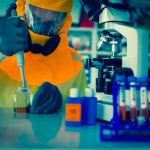Sarcoma
Sarcoma is a cancer that arises from mesenchymal cells. Malignant tumors made of cancerous bone, cartilage, fat, muscle, vascular, or hematopoietic tissues are considered sarcomas. There are four types of sarcomas:
Osteosarcoma: It is the most common type of bone cancer. Most cases develop in children and young people who are between the ages of 5 and 20, making it the third most common cancer in young people (after leukemia and brain tumors). Osteosarcoma usually develops in the larger bones, such as the thigh bone (femur) or the shin bone (tibia).
Ewing’s sarcoma: Ewing’s sarcoma usually develops in pelvis, thigh bone or shin bone and most commonly occers in children and young people aged between 10 and 20 years.
Chondrosarcoma: This type of bone cancer usually develops in adults who are between the ages of 40 and 50. The most common sites for chondrosarcoma to develop are pelvis, thigh bone, upper arm bone, shoulder blade (scapula) and the ribs.
Spindle cell sarcoma: Spindle cell sarcoma is very similar to osteosarcoma in terms of its symptoms and treatment, but it affects older adults aged 40 or over.
Symptoms
The most common symptom of bone cancer is bone pain. It generally begins with a feeling of tenderness in the affected bone, and then gradually progresses to a persistent ache that often feels worse during the night or while using the affected bone. Others symptoms of bone cancer include:
A high temperature (fever) of 38C (100.4F) or above
Unexplained weight loss
Sweating usually at night
Causes
Cancer generally begins with the change in the DNA structure known as mutations.
Diagnosis
X-rays: X-rays can often detect damage to the bones that is caused by cancer or any new bone that's growing because of cancer.
MRI scan: An MRI scan is an effective way of assessing the size and spread of any cancerous tumor inside the bones.
Biopsy: The other most definitive way of diagnosing bone cancer is to take a sample of affected bone and send it to a laboratory for testing. This is known as biopsy.
Treatments
Chemotherapy: It is generally done to shrink the size of tumours and to treat any cancerous cells that may have spread.
Surgery: Following chemotherapy, surgery may be carried out to remove the section of cancerous bone. In many cases, it is possible to reconstruct the bone that has been removed. This is known as limb-sparing surgery. Following surgery, further chemotherapy treatment may be given to destroy any remaining cancerous cells.
Radiotherapy: It is also used for treatment and is particularly helpful for some types of cancer (such as Ewing’s sarcoma).
References:
NHS
NHS
Cancer.Net
Sarcoma Uk









